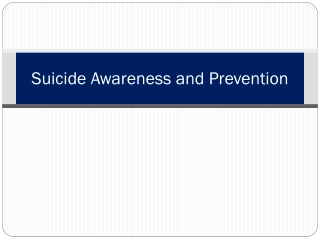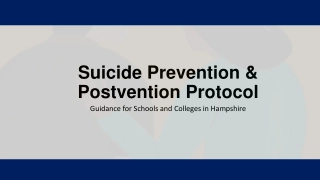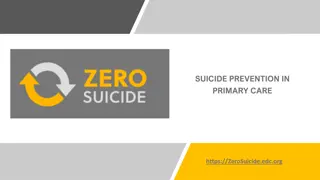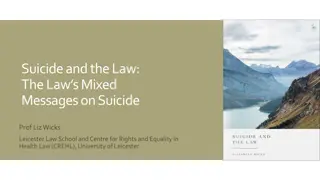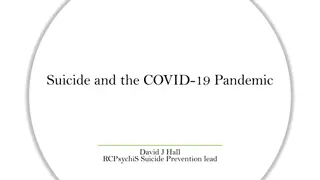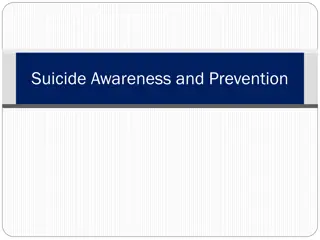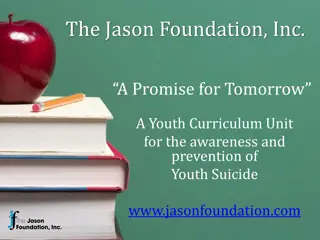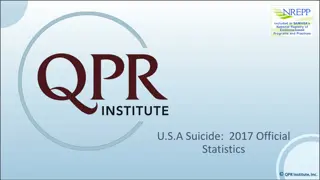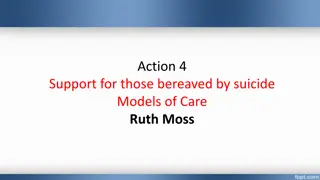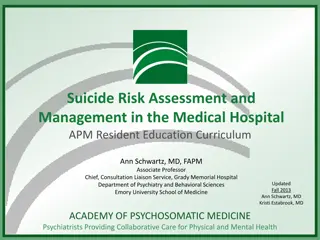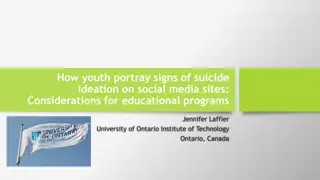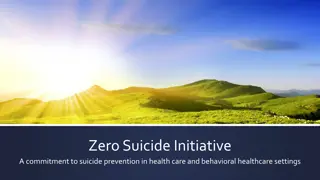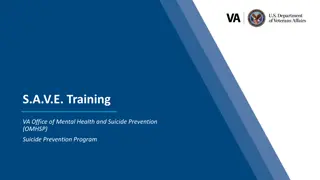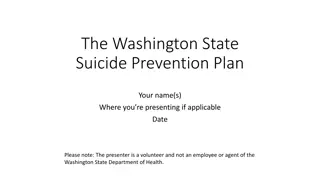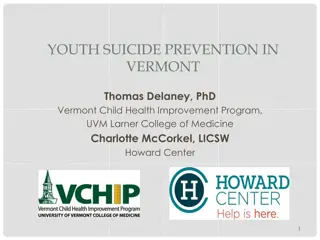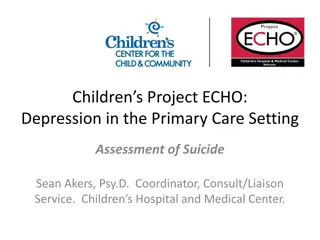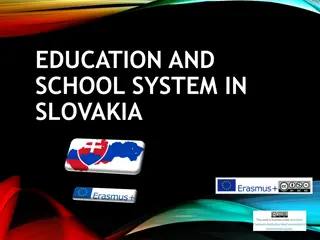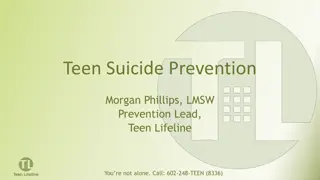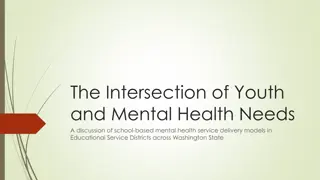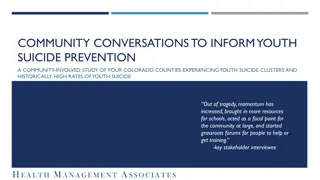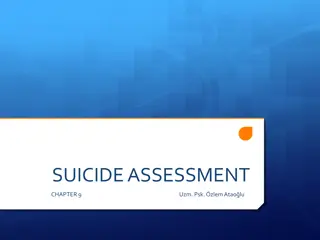Supporting Schools After a Suicide: Postvention Toolkit Overview
Understanding postvention as a crucial aspect of suicide prevention in schools. Key considerations, guidelines, and language recommendations to support grieving students and staff, return to normal routines, identify at-risk individuals, and prevent contagion. Emphasizes the importance of treating all student deaths with sensitivity and consistency. Crisis planning and prevention strategies are highlighted as essential for school communities.
Download Presentation

Please find below an Image/Link to download the presentation.
The content on the website is provided AS IS for your information and personal use only. It may not be sold, licensed, or shared on other websites without obtaining consent from the author.If you encounter any issues during the download, it is possible that the publisher has removed the file from their server.
You are allowed to download the files provided on this website for personal or commercial use, subject to the condition that they are used lawfully. All files are the property of their respective owners.
The content on the website is provided AS IS for your information and personal use only. It may not be sold, licensed, or shared on other websites without obtaining consent from the author.
E N D
Presentation Transcript
POSTVENTION AFTER A SCHOOL SUICIDE After a Suicide: A Toolkit for Schools includes an overview of key considerations, general guidelines for action, do s and don ts, templates, and sample materials, all in an easily accessible format applicable to diverse populations and communities. Suicide Prevention Resource Center
Overview of Postvention Postvention is caring for students and staff after a suicide. The goals of postvention are to: support those grieving the loss of a classmate, teacher, or colleague return the school to its normal routines identify and assist those at risk for unhealthy behaviors, and reactions refer those who may be at risk for psychiatric disorders reduce the risk of contagion for those at risk for suicidal behavior 2
Keep in mind Schools should strive to treat all student deaths in the same way. Having one approach for a student who dies of cancer (for example) and another for a student who dies by suicide reinforces the unfortunate stigma that still surrounds suicide and may be deeply and unfairly painful to the deceased student s family and close friends. 3
Terms Used and Suggested Language Postvention: A coordinated and comprehensive set of specific interventions to be implemented after a crisis or traumatic event has occurred. Gatekeeper: Term used to define the role of the individuals who are routinely in direct contact with a specified target audience who are trained to know basic suicide prevention steps . Gatekeepers are trained to recognize and respond appropriately to warning signs of suicidal behavior and to assist at-risk individuals in getting the help they need. Contagion: A phenomenon whereby susceptible persons are influenced towards suicidal behavior through knowledge of another person s suicidal acts. Crisis response plan: A document that spells out the procedures to be followed in the event of threatening situations. Crisis team: A group of individuals trained and assembled for the purpose of responding to the needs of other during and after a crisis event/situation. 4
PLEASE do not say COMMITTED SUICIDE Please be respectful and say someone DIED BY SUICIDE 5
Crisis Planning is First! Crisis plans for suicide prevention should be completed and provided to school staff before there is a crisis. Overall Suicide Prevention Planning should start with Prevention. Postvention follows the school crisis plan for AFTER a Suicide. 6
Lessons From Loss Those Who Have Been There Most folks get by through their natural supports Schools are often expected to serve as the only supports for some students Grieving is life long. We can often get triggered by another s loss. A crisis can also be a window of opportunity to get help Anger is as common a response to loss as sadness - there will be conflict It is often two years after a loss that it hits us - Paula McCommons, STAR Center 7
Prevention Train all school personnel (e.g. faculty, aides, administrators, bus drivers, secretaries, crossing guards, coaches, janitors, probation officers, nurses, counselors etc.) parents and other gatekeepers on youth highest at risk for suicide: Males 16 19 Youth with mental health/ drug & alcohol problems GLBTQ youth Youth who have attempted suicide in the past Teens with an impending disciplinary action and other risk factors 8
Why is Postvention considered Prevention and Equally Important? There are special considerations with a death by suicide. Balancing the threat of contagion with the opportunity to get students help. Talking about suicide does not cause it, but exposure to another s suicide becomes a risk factor for suicide especially among teens. The threat of a suicide cluster is higher for those at risk but generally youth do not know the young person who died. A cluster can also be triggered by the death of a celebrity. Teens are more vulnerable to the media coverage of a teen suicide than adults (6.9% to .9%) Although close friends may not attempt, at 6 mo. after a friend s completion, they met the criteria for MDD (29%) and PTSD (6%) 9
Six months after a peer suicide, exposed youth are at greater psychiatric risk than youth not exposed to a peer suicide. 4 x more likely to develop a MH disorder 6 x more likely to develop major depression More likely to develop PTSD Most of the risk occurs within the first month of the exposure Siblings showed less traumatic grief perhaps more opportunity to grieve or receive more support
And more findings Complicated/ traumatic grief is real, especially in teens surviving a peer suicide: Severe impaired functioning Longing for and often preoccupation of victim Not accepting the death Hopeless and purposeless about the future Loss of security Anger, bitterness Numbness and detachment Unable to reinvest new energy in life- stuck 11
Even 6 yrs. after a death, those with traumatic grief had 5 x higher rate of suicide ideation than their other exposed peers! So lets start 12
School Crisis Intervention Plan Your school should have a crisis plan that lays out the steps recommended for what the school s response is after a tragic death. examples: http://theguide.fmhi.usf.edu/ http://www.doe.virginia.gov/support/safety_crisis_management/emergency_crisis_management/model_plan.pdf 13
Definitions What is a School Crisis? It is a sudden, unexpected, or unanticipated critical incident that disrupts the school day and may interfere with teaching, learning, attendance and behavior. Implies that the individual s usual coping mechanisms may not be sufficient to handle a particular situation. Include: experiencing, witnessing, and/or learning about and event that involves the actual death or physical injury, and or threatened death or physical injury (APA, 2000, p.463). What is the purpose of Crisis Intervention? To restore the individuals involved to pre-crisis levels of functioning by: Assuring that tragic events or occurrences are not ignored. Assisting students, faculty, parents and other school staff in dealing with emotional responses. Decreasing the proliferation of rumors through the sharing of facts. Securing and coordinating the services of community agencies as needed. 14
Crisis Response Once a suicide death has been confirmed, the school should immediately implement a coordinated crisis response in order to: Effectively manage the situation; Provide opportunities for grief support; Maintain an environment focused on normal educational activities; Help students cope with their feelings, and minimize the risk of suicide contagion. What follows can be used by any school, regardless of whether there is a pre-existing Crisis Response Plan in place. 15
First Steps Your school crisis plan should go into effect the moment someone from your school hears of a youth suicide. The Steps to take are laid out in the Plan- Such as the School Principal should be informed He/She contacts ????? Who contacts ???? THEN Get the Facts! 16
Follow the Plan! Confirm the Cause of Death The school s principal or designee If the Cause of Death Is Unconfirmed and death is confirmed Schools should state that the cause of death is still being determined and that additional information will be forthcoming once it has been confirmed. Acknowledge that there are rumors (which are often inaccurate), and remind students that rumors can be deeply hurtful and unfair to the missing/ deceased person, their family, and their friends. 17
If family does not want cause disclosed While the fact that a student has died may be disclosed immediately, information about the cause of death should not be disclosed to students until the family has been consulted. If the death has been declared a suicide but the family does not want it disclosed, someone from the administration or counseling staff who has a good relationship with the family should be designated to contact them to explain that students are already talking about the death amongst themselves, and that having adults in the school community talk to students about suicide and its causes can help keep students safe. 18
If the family refuses to permit disclosure, schools can state, The family has requested that information about the cause of death not be shared at this time and can nevertheless use the opportunity to talk with students about the phenomenon of suicide: We know there has been a lot of talk about whether this was a suicide death. Since the subject of suicide has been raised, we want to take this opportunity to give you accurate information about suicide in general, ways to prevent it, and how to get help if you or someone you know is feeling depressed or may be suicidal. 19
How Information is Shared with Students How the information is shared is just as important as what is shared. Students should be notified of the death in small groups such as homerooms or advisories (not by overhead announcement or in a large assembly). Each teacher should have the same script. Examples are in the manual. 20
Option 1 When the death has been ruled a suicide It is with great sadness that I have to tell you that one of our students, _________, has taken [his/her] own life. All of us want you to know that we are here to help you in any way we can. A suicide death presents us with many questions that we may not be able to answer right away. Rumors may begin to circulate, and we ask that you not spread rumors you may hear. We ll do our best to give you accurate information as it becomes known to us. Suicide is a very complicated act. It is usually caused by a mental disorder such as depression, which can prevent a person from thinking clearly about his or her problems and how to solve them. Sometimes these disorders are not identified or noticed; in other cases, a person with a disorder will show obvious symptoms or signs. One thing is certain: there are treatments that can help. Suicide should never, ever be an option. Each of us will react to _____ s death in our own way, and we need to be respectful of each other. Feeling sad is a normal response to any loss. Some of you may not have known ______very well and may not be as affected, while others may experience a great deal of sadness. Some of you may find you re having difficulty concentrating on your schoolwork, and others may find that diving into your work is a good distraction. We have counselors available to help our school community deal with this sad loss and to enable us to understand more about suicide. If you d like to talk to a counselor, just let your teachers know. Please remember that we are all here for you. 21
Crisis Response Team Leaders Checklist Inform the school superintendent of the death. Contact the deceased s family to offer condolences, inquire what the school can do to assist, discuss what students should be told, and inquire about funeral arrangements. Call an immediate meeting of the Crisis Response Team to assign responsibilities. Establish the plan to immediately notify faculty and staff of the death via the school s crisis alert system (usually phone or e-mail). Schedule an initial all-staff meeting as soon as possible (ideally before school starts in the morning). Arrange for students to be notified of the death in small groups such as homerooms or advisories (not by overhead announcement or in a large assembly). Disseminate a death notification statement (ex. Provided in toolkit) for students to homeroom teachers, advisors, or others leading those groups. Draft and disseminate a death notification statement for students parents. Also include information on how to help their child. Speak with school superintendent and Crisis Response Team Coordinator throughout the day. Determine whether additional grief counselors and other resources may be needed from outside the school. Usually the school will have an understanding with community mental health resources to counsel students throughout the day. 22
Sample Death Notification Statement for Parents To be sent by e-mail or regular mail Option 1 When the death has been ruled suicide I am writing with great sadness to inform you that one of our students, ________, has died. Our thoughts and sympathies are with [his/her] family and friends. All of the students were given the news of the death by their teacher in [advisory/homeroom] this morning. I have included a copy of the announcement that was read to them. The cause of death was suicide. We want to take this opportunity to remind our community that suicide is a very complicated act. It is usually caused by a mental disorder such as depression, which can prevent a person from thinking clearly about his or her problems and how to solve them. Sometimes these disorders are not identified or noticed; other times, a person with a disorder will show obvious symptoms or signs. I am including some information that may be helpful to you in discussing suicide with your child. Members of our Crisis Response Team are available to meet with students individually and in groups today as well as over the coming days and weeks. Please contact the school office if you feel your child is in need of additional assistance; we have a list of school and community mental health resources. Information about the funeral service will be made available as soon as we have it. If your child wishes to attend, we strongly encourage you to accompany him or her to the service. If the funeral is scheduled during school hours, students who wish to attend will need parental permission to be released from school. The school will be hosting a meeting for parents and others in the community at [date/time/location]. Members of our Crisis Response Team [or mental health professionals] will be present to provide information about common reactions following a suicide and how adults can help youths cope. They will also provide information about suicide and mental illness in adolescents, including risk factors and warning signs of suicide, and will address attendees questions and concerns. Please do not hesitate to contact me or one of the school counselors with any questions or concerns. Sincerely, [Principal] 23
Safety Keep to regular school hours. Insure that students follow established dismissal procedures. Do Not let students leave the school and encourage parents to not let them leave the school. Have a safe room with counselors that students can go to throughout the day. Call on school resource officers or plant manager to assist parents and others who may show up at the school and to keep media off of school grounds. Pay attention to students who are having particular difficulty, including those who may be congregating in hallways and bathrooms, and encourage them to talk with counselors or other appropriate school personnel. 24
Operations Assign a staff or faculty member to follow the deceased student s schedule to monitor peer reactions and answer questions. If possible, arrange for several substitute teachers or floaters to be on hand in the building in case teachers need to take time out of their classrooms. Arrange for crisis counseling rooms for staff and students. Provide tissues and water throughout the building and arrange for food for faculty and crisis counselors. Work with administration, faculty, and counselors to identify individuals who may be having particular difficulty, such as close friends, and teammates; those who had difficulties with the deceased; those who may have witnessed the death; and students known to have depression or prior suicidality; and work with school counseling staff to develop plans to provide psychological first aid. 25
Memorialization Prepare to track and respond to student and/or family requests for memorialization (A protocol for memorials should already be a part of school plans. Discourage students who want to leave things by the deceased students locker and provide a less conspicuous place, perhaps at the end of a hallway. Leave this space available and tell students that after a week the gifts will go to the family) 26
Funeral Communicate with the funeral director about logistics, including the need for crisis counselors and/or security to be present at the funeral. Discuss with the family the importance of communicating with clergy or whomever will be conducting the funeral to emphasize the importance of connecting suicide to underlying mental health issues (such as depression) and not romanticizing the death in ways that could risk contagion. Depending on the family s wishes, help disseminate information about the funeral to students, parents and staff, including: location time of the funeral (keep school open if the funeral is during school hours) what to expect (for example, whether there will be an open casket) guidance regarding how to express condolences to the family policy for releasing students during school hours to attend (i.e., students will be released only with permission of parent, guardian, or designated adult) Work with school counselors and community mental health professionals to arrange for counselors to attend the funeral. Encourage parents to accompany their child to the funeral. 27
Social Media Oversee school s use of social media as part of the crisis response. Consider convening a small group of the deceased s friends to work with school administration to monitor social networking sites and other social media. It may also be useful for school staff to identify and reach out to families of students who are not coming to school. 28
Schools need to prepare to do the following: Help students cope in the short term by creating a protocol that describes specific steps to take after a suicide If possible, have counselors go into the classrooms to give information about suicide, the kinds of reactions that can be expected after hearing about a peer s suicide death, and safe coping strategies to help them in the coming days and weeks. Wherever possible, group meetings should follow a structured outline, keep to a time limit, and provide each student with an opportunity to speak. The meetings should focus on helping students identify and express their feelings and discuss practical coping strategies (including appropriate ways to memorialize the loss) so they may return their focus to their regular routines and activities. Continue helping students cope over the long term, since emotional fallout from a suicide can continue for months, and even years after the death. 29
Ask Students About How they ve coped with difficulties in the past and remind them that they can use those same coping skills now Ask them to write a list of people they can turn to for support Remind them that may feel guilty about having fun or thinking about other things. That is normal. Students should also be encouraged to think about how they want to remember their friend. It is not a good idea to plant a tree or another permanent memorial. Ideas range from writing a personal note to the family, to attending the memorial service, to doing something kind for another person in honor of their friend. A day of caring, cleaning a park, having a fundraiser for suicide prevention. 30
Implications for Postvention: Ideally, screen, ASAP, not only siblings, close friends, and those directly exposed, but also acquaintances and those in the general student body who are: Experiencing issues with other losses/deaths Using drugs and alcohol Have an affective disorder (e.g. anxiety) Appear upset Conduct follow up screenings at 1, 3, 6, 9 and 12 months out. 31
Schools should not Unintentionally glamorize a youth that died by suicide Suggest that the death was caused by a single problem, such as a breakup with a girlfriend or boyfriend Provide a detailed description of how the youth died. Schools should Emphasize that the student who died by suicide was most likely struggling with a mental disorder, such as depression or anxiety, that can cause substantial psychological pain but may not have been apparent to others. Keep informed of the types of information being shared on social media (facebook, on-line condolences) Provide students with hotline numbers and other resource information that kids can post. 32
Memorializations In the case of suicide, schools must consider how to appropriately memorialize the student who died without risking suicide contagion among other students who may themselves be at risk. It is very important that schools strive to treat all deaths in the same way. Having one approach for memorializing a student who died of cancer or in a car accident and a different approach for a student who died by suicide reinforces stigma and may be deeply and unfairly painful to the student s family and friends. Schools should strongly encourage parents whose children express an interest in attending the funeral to attend with them. 33
Schools should have a consistent policy so that suicide deaths are handled in the same manner as any other deaths. For example, schools may wish to make posterboard and markers available so that students can gather and write messages. It is advisable to set up the posters in an area that may be avoided by those who don t wish to participate (i.e., not in the cafeteria or at the front entrance). After a few days, the posters can be removed and offered to the family. 34
Ideas holding a day of community service or creating a school-based community service program in honor of the deceased putting together a team to participate in an awareness or fundraising event sponsored by one of the local mental health or suicide prevention organizations sponsoring a mental health awareness day purchasing books on mental health for the school or local library working with the administration to develop and implement a curriculum focused on effective problem-solving raising funds to help the family defray their funeral expenses making a book available in the school office for several weeks in which students can write messages to the family, share memories of the deceased, or offer condolences; the book can then be presented to the family on behalf of the school community 35
When a memorial is spontaneously created on school grounds, schools are advised to monitor it for messages that may be inappropriate (hostile or inflammatory) or that indicate students who may themselves be at risk. Schools can leave such memorials in place until after the funeral (or for up to approximately five days), after which the tribute objects may be offered to the family. It is recommended that schools discourage requests to create and distribute t-shirts and buttons bearing images of the deceased by explaining that, while these items may be comforting to some students, they may be quite upsetting to others. If students come to school wearing such items without first seeking permission, it is recommended that they be allowed to wear the items for that day only. 36
Since the emptiness of the deceased students chair can be unsettling and evocative, after approximately five days (or after the funeral), seat assignments may be re-arranged to create a new environment. Teachers should explain in advance that the intention is to strike a balance between compassionately honoring the student who has died while at the same time returning the focus back to the classroom curriculum. The students can be involved in planning how to respectfully remove the desk; for example, they could read a statement that emphasizes their love for their friend and their commitment to work to eradicate suicide in his or her memory. 37
Resources for Postvention Preventing Suicide A TOOLKIT FOR HIGH SCHOOLS - SAMHSA page 88-91 Examples of sample scripts /guidelines/letters/guidelines for memorializations Page 92-109 Postvention Manual Star Center - Services for Teens At Risk http://www.starcenter.pitt.edu/Files/PDF/Manuals/Postvention.pdf After a Suicide: A Toolkit for Schools Suicide Prevention Resource Center http://www.sprc.org/sites/sprc.org/files/library/AfteraSuicideToolkitforSchools.pdf 38
Suicide Prevention After your school develops Protocols and Policies -Your school should have staff education and training, and a training for students (ex. Signs of Suicide toolkit and screening option) - An important step to a comprehensive school suicide prevention program, parent education and outreach program. SAMHSA s TOOLKIT page 128-138 Video- What Every Parent Should Know -Society for the Prevention of Teen Suicide 39
Student Programs Because Kids Tell Kids .. Educate and involve students in good mental health and suicide prevention Resource is SAMHSA TOOLKIT Training (Chapter 6) and Screening (Chapter 7) Signs of Suicide Program Resource Section 40
NOW..START A SCHOOL TEAM for the Saturday, September 12, 2015 Share the Journey Walk for Suicide Prevention 41


